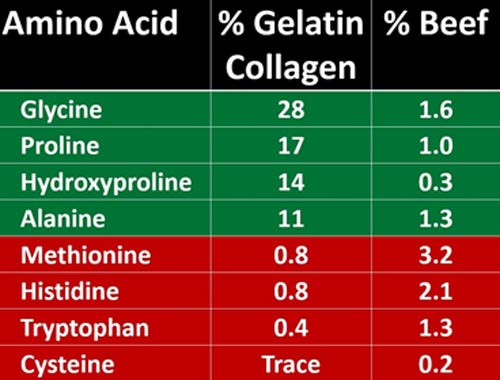Story at-a-glance
- On February 1, 2024, General Mills launched “LOADED,” a new cereal line with enlarged squares of popular cereals filled with artificially flavored vanilla creme, but tests reveal alarming levels of heavy metals in Trix LOADED
- Trix LOADED contains more than double the EPA’s allowable level for lead, 400% higher levels of cadmium, and up to 1,650% higher aluminum levels than EPA standards for drinking water
- The European Food Safety Authority’s weekly aluminum intake limit is nearly reached by daily consumption of Trix LOADED, not accounting for other aluminum exposure sources. Glyphosate and eight pesticides were also detected
- Processed cereals are major sources of linoleic acid (LA), which may impair mitochondrial function and contribute to chronic disease
- Bone broth is a nutritious alternative to cereal. Bone broth contains important amino acids that few people get enough of, such as glycine and proline, which are important for longevity and overall health
February 1, 2024, General Mills, Inc. launched a new breakfast cereal line called “LOADED.” The new line features enlarged squares of popular cereals — Cinnamon Toast Crunch, Trix, and Cocoa Puffs — filled with artificially flavored vanilla creme.
Testing1 by Moms Across America (MAA) now reveal Trix LOADED (the only LOADED cereal included in this preliminary test) contains aluminum, cadmium, arsenic and lead, in some cases far exceeding the U.S. Environmental Protection Agency’s allowable levels in drinking water. For example, the two Trix LOADED samples contained:
- More than double the EPA’s allowable level for lead
- 400% higher levels of cadmium than what the EPA allows
- 1,365% and 1,650% higher levels of aluminum than what the EPA allows
As noted by Epoch Times reporter Megan Redshaw:2
“In 2008, the European Food Safety Authority established a ‘tolerable weekly intake’3 of 1 mg of aluminum per kg of body weight per week, based on combined evidence from animal studies that assessed dietary administration of aluminum compounds.
Using European Union standards, if a child eats a 40-gram serving of Trix LOADED cereal daily, the weekly consumption of aluminum would be 0.98 mg/week based on one sample and 0.82 mg/week based on the other.
This is roughly equal to the EU’s limit without considering other sources of aluminum exposure, such as flour, baking soda, medications, processed foods, and aluminum pots and pans.”
Toxic Pesticides Detected
Glyphosate and eight different pesticides were also detected. While most had only trace levels, two — piperonyl butoxide-1 (PBO) and fluopyram-1 — were found at higher levels.
PBO is a broad-spectrum fungicide that has been linked to liver problems, endocrine disruption, neurodevelopmental problems and thyroid cancer. The U.S. classifies it as a “possible human carcinogen” based on animal studies. Glyphosate also has carcinogenic potential. The International Agency for Research on Cancer (IARC) classifies it as “probably” carcinogenic to humans. As reported by Redshaw:4
“Glyphosate, the most widely used herbicide in the world, was found in both samples of Trix LOADED cereal at 15.83 ppb and 17.47 ppb … Studies have confirmed a link between glyphosate and numerous health conditions, including cancers and nervous system disorders.
Additionally, Monsanto, now Bayer, agreed to pay roughly $11 billion to settle claims filed by individuals who say Roundup caused their non-Hodgkin lymphoma or other related cancers. As of March, there are 4,253 cancer lawsuits, out of the 4,800 claims originally filed, still pending in the California Roundup multi-district litigation.
In research5 published by the University of California, Berkeley School of Public Health, scientists found that childhood exposure to glyphosate is linked to liver inflammation and metabolic disorders in adulthood that could lead to liver cancer, diabetes, and cardiovascular diseases later in life.
Researchers found high levels of glyphosate residue in the urine of children and adolescents and reported that diet was a key source of exposure — as levels were higher in those who consumed more cereals and carbohydrates.”
MAA Calls on General Mills to Clean Up Its Product Line
In an email provided to The Epoch Times, the MAA called on General Mills to source ingredients from suppliers that do not use glyphosate or other chemicals as a drying agent and/or preharvest weedkiller. MAA is also urging the company to:
- Phase out the use of glyphosate as a weedkiller within one to two years.
- Test all fertilizers used for heavy metal contaminants and shift to using only the safest ones.
- Support and promote regenerative organic farming practices.
MAA director Zen Honeycutt told The Epoch Times:
“We hope consumers will learn the truth about the contents of LOADED cereal and make choices to support their family’s health. We also hope they [consumers] will alert their elected officials that these types of foods, with high heavy metals and agrochemicals, have no place in the American food supply.”
Avoid All Processed Cereals
While heavy metal and pesticide contaminants are certainly reason enough to avoid processed cereals, they’re not the only ones. Cereals of all kinds are also loaded with seed oils, and are therefore a major source of linoleic acid (LA), which I believe may be the biggest contributor to chronic disease in the Western world — far greater than refined sugar.
The main reason why excess LA causes disease is because it prevents your mitochondria from working well. I describe this process in my 2023 scientific review published in the journal Nutrients,6 coauthored by Christopher D’Adamo.
In summary, mitochondria are subcellular organelles responsible for producing most of your cellular energy in the form of ATP, and without ATP, your cells cannot function and repair themselves normally.
Polyunsaturated fats like LA are easily damaged by oxygen in a process called oxidation, which triggers the creation damaging free radicals. These, in turn, give rise to advanced lipoxidation end products (ALEs), and in the case of omega-6 fats, oxidized linoleic acid metabolites (OXLAMs).
These ALEs and OXLAMs are what cause mitochondrial dysfunction, which is a hallmark of most all chronic disease. In addition to oxidation, inflammation and mitochondrial dysfunction, seed oils can also:
|
Damage the cells lining your blood vessels |
|
Cause memory impairment and increase your risk of Alzheimer’s disease (canola oil, in particular, has been linked to Alzheimer’s) |
|
Strip your liver of glutathione thereby lowering your antioxidant defenses |
|
Inhibit delta-6 desaturase (delta-6), an enzyme involved in the conversion of short-chained omega-3s to longer chained omega-3s in your liver |
|
Impair your immune function and increase mortality |
|
Make your fat cells more insulin sensitive, thereby causing insulin resistance |
|
Inhibit cardiolipin, an important fat in the inner membrane of your mitochondria |
Why Bone Broth Is the Breakfast (and Dinner) of Choice
The CEO of Kellogg recently made headlines when he suggested families struggling with rising food prices ought to consider eating cereal for dinner. Clearly, that’s got to be one of the worst dietary recommendations so far. As noted by Dr. Paul Saladino in the video above, it won’t even save you money.
However, while Saladino recommends ground beef as a superior option, I believe there’s an even better alternative: bone broth, either by itself or as a soup or stew base or used as the water to cook white rice. Why?
Because isolated muscle meats are high in methionine, tryptophan and histidine, all of which have been shown to correlate with a decrease in longevity. Meanwhile, the amino acids in collagen — glycine, proline, hydroxyproline and alanine — are associated with improved health and disease prevention.
As just one example, glycine plays several critical roles in the brain, impacting cognition, mood and overall neurological function. It serves both as a neurotransmitter and a neuromodulator in the central nervous system, and helps reduce neuronal excitability, leading to a calming effect on the brain.

Medical science has arguably done us a disservice by classifying glycine and proline as only “conditionally essential” rather than “essential.” The rationale has been that since the body can synthesize them de novo (from other raw materials), they need not be emphasized in our diet.
This perspective, however, misses a crucial nuance: your body’s capacity to generate these amino acids does not match the levels required for optimal health. This mismatch, in effect, renders them essential — vital components that must be sourced from our diet to prevent deficiency and support maximal lifespan.
Historically, the consumption of connective tissue was commonplace, largely through the intake of gelatin-rich foods like Jello desserts and other sources of connective tissue. Gelatin, a processed form of collagen, contains these “conditionally essential” amino acids and played a more significant role in the diets of our ancestors. This dietary habit unknowingly supported a balance that modern diets do not.
The reality is you need about one-third of your daily protein intake to come from collagen sources. If you don’t, eventually your body’s structural integrity, joint health, and the myriad processes that these amino acids support — from wound healing to the maintenance of healthy skin and the prevention of aging-related decline — will falter.
So, rather than eating beef for breakfast, a far better alternative would be to drink some homemade bone broth.
The call to reintegrate connective tissue into our diets is not merely a nod to tradition but a backed-by-science approach to reclaiming an aspect of nutrition pivotal for longevity. It’s about redefining what we view as “essential” in our diets and recognizing that, for optimal health and the longest possible lifespan, we must look beyond the macronutrients and micronutrients that have dominated dietary advice.
In short, we must ensure that collagen and its critical amino acids are not just present but abundant in our daily diet. If you balance your red meat intake with collagen, then red meat is fine, but eating muscle meat alone can be problematic. To learn more about this, see “Why Collagen Is a Proven Necessity.”
The Easy Way to Make Bone Broth
The best source of collagen is homemade bone broth, which you can whip up in four hours using a pressure cooker such as an Instant Pot. Simply place the bones in the Instant Pot, cover the bones with pure, filtered water, add salt and other spices to taste, then set it to cook on high for two hours if the bones are CAFO, and four hours if organic and grass fed.
Organic grass fed beef bones are the best. Using bones from CAFO (concentrated animal feeding operation) beef can be problematic due to potential heavy metal contamination. When cooking these bones in a pressure cooker, it’s best to limit the time to two hours to avoid introducing heavy metals into your broth.
If you’re using beef bones from grass fed organic sources, you can safely cook them for four hours. Using bones from an organic source is even more important if you’re using chicken, as CAFO chickens tend to produce stock that doesn’t gel,7 which raises questions about the quality of the collagen you’re getting.
When preparing bone broth at home, it is important to chill the bone broth before you eat so the fat will rise to the top and you can skim it off. While some beef fat is good, excess can be problematic.
Source: Source link
Publish Date: 4/11/2024 12:00:00 AM

